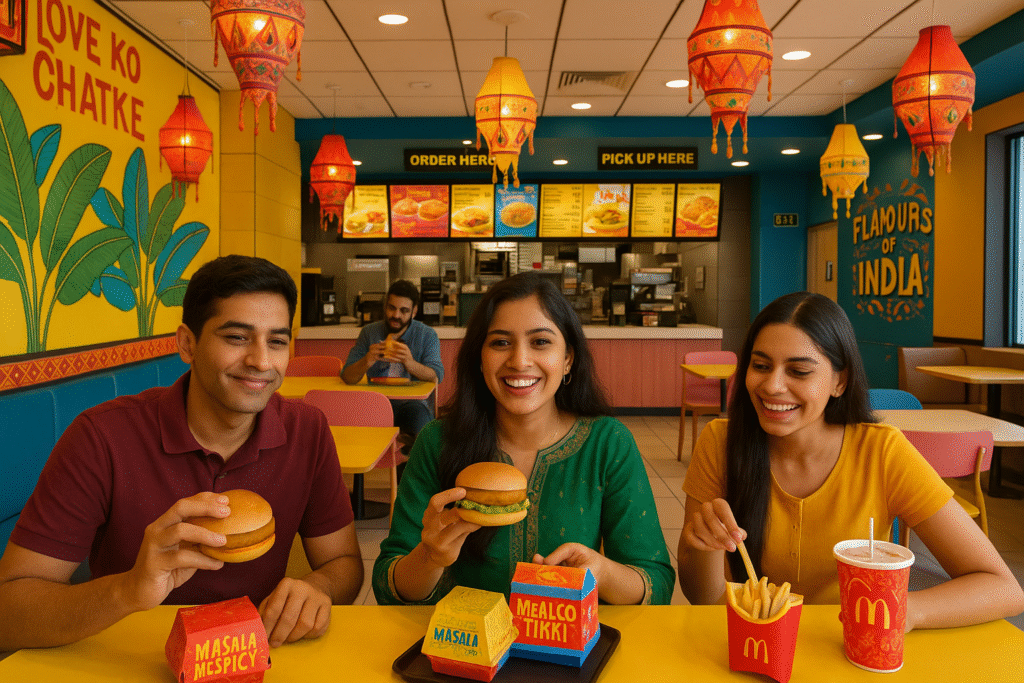Explore how McDonald’s is customizing its menu in India with regional flavors, spices, and cultural favorites to win over local hearts and appetites.
🍔 How McDonald’s Is Localizing Its Menu for Indian Palates
In a country as vast and diverse as India, food is more than just a necessity—it’s an emotional experience. Spices, regional variations, and deeply rooted food traditions make India a tough market to crack for international food chains. But one brand that’s doing it right? McDonald’s India.
Let’s take a flavorful dive into how McDonald’s is localizing its menu to cater to Indian palates, winning hearts (and stomachs) across the subcontinent.
🛤️ The Journey of McDonald’s in India

Discover how McDonald’s is spicing up its menu to match India’s diverse tastes and cultural cravings.
When McDonald’s entered India in 1996, it was clear from the get-go that the American fast-food giant couldn’t just replicate its U.S. playbook. India’s cultural and dietary preferences posed a unique challenge—a largely vegetarian population, regional taste diversity, and sensitivities around beef and pork consumption.
So what did McDonald’s do? It innovated.
🌶️ Spicing Up the Menu: Local Flavors, Global Format
One of McDonald’s smartest moves was introducing India-specific menu items. Over the years, the menu has evolved to reflect changing trends and deeper local integrations.
⭐ Signature Indian Items You’ll Only Find Here:
- McAloo Tikki Burger: A spicy potato and pea patty wrapped in a soft bun. A true desi legend.
- Masala McEgg: Packed with Indian spices, a twist on the traditional egg sandwich.
- McSpicy Paneer: Because paneer is life! Crunchy, spicy, and satisfying.
- Chicken Maharaja Mac: India’s take on the Big Mac—minus the beef, plus the flavor!
- Piri Piri Fries: French fries, but better—coated with a zesty spice mix.
- Dosa Masala Burger (limited edition): South India meets fast food in the best way.
These aren’t just food items—they’re symbols of how McDonald’s understands local sentiment.
🛍️ Culturally Tuned Packaging & Promotions
McDonald’s India goes beyond just food. Its festive packaging during Diwali, Holi, or Independence Day evokes emotional connections. Limited-time offers like the Great Indian Taste Fest capitalize on local buying behavior and festive moods, making the experience more relatable.
🤝 Vegetarian and Non-Beef Commitment
McDonald’s took a massive step by separating vegetarian and non-vegetarian kitchens, something few global chains have attempted. There are even fully vegetarian outlets in places like Vaishno Devi and Gujarat, respecting religious and cultural sentiments.
This isn’t just good business—it’s a respectful move that builds trust.
🍽️ Regional Variations for Regional Cravings
From North to South, East to West, the Indian McDonald’s menu reflects regional identities:
- South India: More rice-based and spicy items like the McSpicy Chicken Rice Bowl.
- West India: Tangier flavors and creative combos like Mexican cheesy fries.
- East India: Balanced spice with a hint of sweetness in offerings.
- North India: Richer, heavier flavors, catering to Punjabi and Mughlai preferences.
This kind of regional tailoring isn’t common with global brands—and it’s working wonders.
📱 Innovation & Delivery Trends
The menu also adapts to changing eating habits. With food delivery booming, McDonald’s introduced combo meals, family packs, and exclusive online offers on Swiggy and Zomato. Their McDelivery app even includes customization options, something Indian customers deeply appreciate.
They’ve also embraced health-conscious trends with no onion/no garlic variants, whole wheat buns, and air-fried items in some cities.
💬 What Indian Customers Say
The sentiment around McDonald’s India is overwhelmingly positive. Many fans appreciate:
- Affordable pricing
- Consistent taste across cities
- Customizable meals
- Hygiene and safety standards
- Nostalgia for first dates, after-college hangouts, and family outings
There’s emotional value attached to eating at McDonald’s in India—it’s more than just a meal; it’s a memory.
🧠 Why Localization Works for McDonald’s
In simple terms: localization equals relevance. Instead of forcing a foreign menu, McDonald’s took time to understand the Indian consumer psyche—their cravings, comfort foods, religious norms, and flavor profiles.
This move isn’t just smart; it’s essential in a market like India, where consumers are increasingly proud of local traditions and expect global brands to adapt—not the other way around.
🧭 Final Bite: Global Brand, Desi Heart
McDonald’s success in India proves a powerful point—you don’t have to lose your global identity to win in a local market. You just need to adapt thoughtfully.
From spicy street-food-inspired burgers to culturally sensitive policies, McDonald’s is setting a gold standard in localization.
So next time you bite into a McAloo Tikki or sip a Choco Frappe, remember—you’re enjoying a global experience wrapped in a delicious layer of Indian flavor.
Disclaimer
This blog is intended for informational and educational purposes only. The views expressed are personal opinions or general insights, not professional or legal advice. Readers should do their own research or consult relevant professionals before taking action based on this content.
#McDonaldsIndia #IndianFastFood #DesiFlavors #LocalizedMenu #FoodieIndia #GlobalBrandsLocalTwist #SpicyBurgers #McAlooTikki #IndianPalate #carrerbook#Anslation#MasalaFlavors #CulturalCuisine #McDonaldsMenu #FoodInnovation #TasteOfIndia #IndianStreetFood

